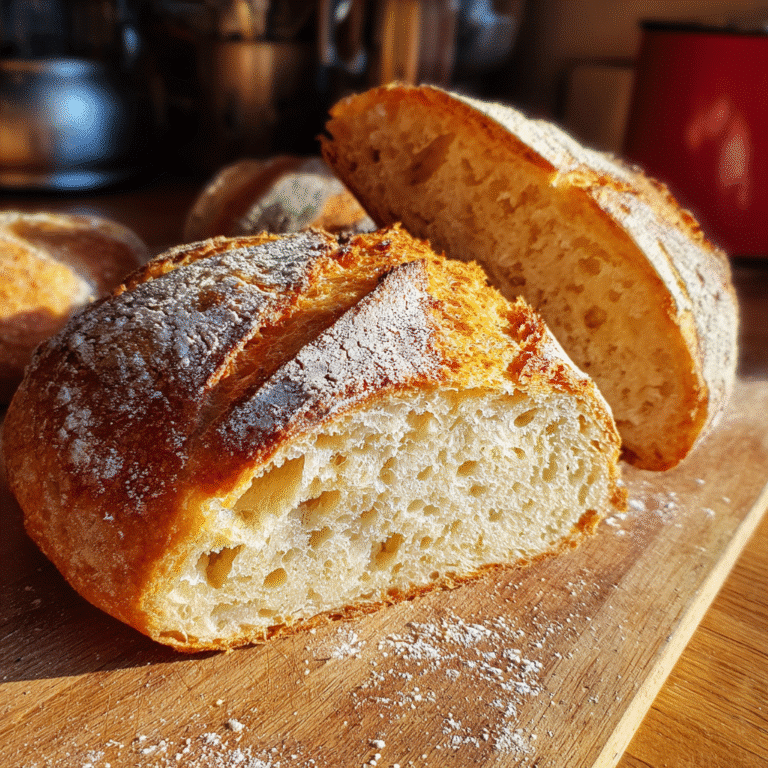There’s something magical about a warm slice of sourdough bread its chewy crust, the tang of fermentation, the soft and airy crumb. But for those of us living gluten-free, that magic often feels just out of reach. I’ve spent years in my Asheville kitchen, flour on my shirt and starter jars crowding my countertops, testing and tweaking recipes to get that perfect loaf without the gluten. And here’s the good news: gluten free sourdough bread is not only possible, it’s downright delicious.
Thank you for reading this post, don't forget to subscribe!In this article, we’re going to roll up our sleeves together and dive into the whole process how it works, what flours to use, how to maintain a gluten-free starter, and why this kind of bread can actually be easier on your digestion. Whether you’re just starting out or you’ve had a few gummy loaves in your past, consider this your go-to guide.
By the end, you’ll be ready to bake a gluten-free sourdough bread that’s every bit as satisfying as its traditional cousin. Oh and if you’re wondering whether you can buy a good one instead of baking from scratch, don’t worry, we’ll cover that too.
Before we dive in, check out this flavorful variation:
Discover great ideas like Blueberry Lemon Sourdough Bread for a fruity spin on a fermented classic.
Table of Contents
Understanding Gluten Free Sourdough Bread
What Makes Sourdough “Sourdough”
Sourdough bread isn’t your average loaf. It’s got character thanks to the slow fermentation process that gives it that unmistakable tang and chewy bite. What sets it apart is the starter: a bubbly mix of flour and water teeming with wild yeast and lactic acid bacteria. No commercial yeast needed. Over time, this live culture breaks down starches, develops flavor, and helps the dough rise.
But here’s the thing: traditional sourdough uses wheat flour, which contains gluten. That means it’s a no-go for people with celiac disease or anyone sensitive to gluten. And even though some folks believe the fermentation “breaks down” gluten, studies show that traditional sourdough still contains enough gluten to cause problems for those who are intolerant.
So what do you do if you want the flavor and texture of sourdough, without the gluten? You start thinking outside the wheat. That’s where gluten free sourdough bread comes in made with non-wheat flours, it’s just as tangy, crusty, and satisfying as the original.
Why Traditional Sourdough Isn’t Gluten Free
The heart of classic sourdough is its flour and standard recipes call for gluten-containing grains like wheat, rye, or spelt. Even though fermentation does break down some gluten proteins, it doesn’t remove them completely.
Here’s a quick comparison:
| Type of Bread | Contains Gluten? | Fermented? | Safe for Gluten-Free Diet? |
|---|---|---|---|
| Traditional Sourdough | Yes | Yes | No |
| Gluten-Free Sourdough | No | Yes | Yes |
| Store-Bought White Bread | Yes | No | No |
To make truly gluten free sourdough bread, we need to swap the wheat flour for gluten-free options and build a starter using the same flours. It’s a bit more finicky, sure, but absolutely worth it when you slice into that golden crust and taste the subtle sour note you’ve been missing.
If you’re gluten sensitive and thought sourdough was off-limits, I promise there’s hope. Gluten free sourdough bread not only exists it shines with its own rustic charm.
And if you’ve never baked sourdough before? Don’t stress.
Check out Sourdough Discard Biscuits to ease into the sourdough world with a quicker bake.
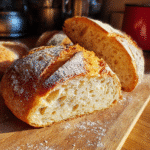
How to Make Gluten-Free Sourdough Bread
- Total Time: 7 hours 35 minutes
- Yield: 1 loaf
Description
A chewy, tangy, and utterly satisfying gluten free sourdough bread—crafted with whole grain flours and a homemade starter.
Ingredients
- 1 1/4 cups brown rice flour
- 1 cup sorghum flour
- 3/4 cup tapioca starch
- 2 tsp psyllium husk powder
- 1 1/4 cups filtered water (room temperature)
- 1/2 cup active gluten-free sourdough starter
- 1 tsp salt
- 1 tsp olive oil (optional)
Instructions
- In a large bowl, combine all the flours and salt.
- Pour in the water, starter, and oil. Stir until a sticky dough forms. Rest for 30 minutes.
- Shape the dough and place in a lined proofing basket or bowl. Let rise for 4–6 hours until aromatic and puffed.
- Preheat the oven to 450°F with a Dutch oven inside.
- Bake covered for 30 minutes, then uncovered for 20 minutes until the crust is golden and sounds hollow.
- Cool completely before slicing.
Notes
Use a kitchen scale for best results. Letting the bread cool fully improves texture and flavor.
- Prep Time: 6 hours 45 minutes
- Cook Time: 50 minutes
- Category: Bread
- Method: Baking
- Cuisine: Gluten-Free
Can You Make Sourdough Gluten Free?
Is Gluten Free Sourdough Bread Possible?
Absolutely it’s not only possible, it’s becoming more and more popular in home kitchens and artisan bakeries across the country. You don’t need to miss out on that classic sour tang just because you’re gluten-free. The secret is in the ingredients and a little patience.
Gluten free sourdough bread swaps out wheat for naturally gluten-free flours like brown rice, sorghum, or millet. And while these flours don’t have the stretchy proteins that traditional sourdough relies on, they can still ferment beautifully. When paired with the right binders like psyllium husk or flaxseed gel, you get a dough that’s easy to handle and bakes into a hearty, wholesome loaf.
In fact, this kind of bread might even surprise you. The crust is golden and crisp, the crumb tender and flavorful. It’s not just a substitute it stands proudly on its own.
Looking for inspiration?
Don’t miss our Sourdough Discard Soda Bread for another naturally fermented favorite made with simple ingredients.
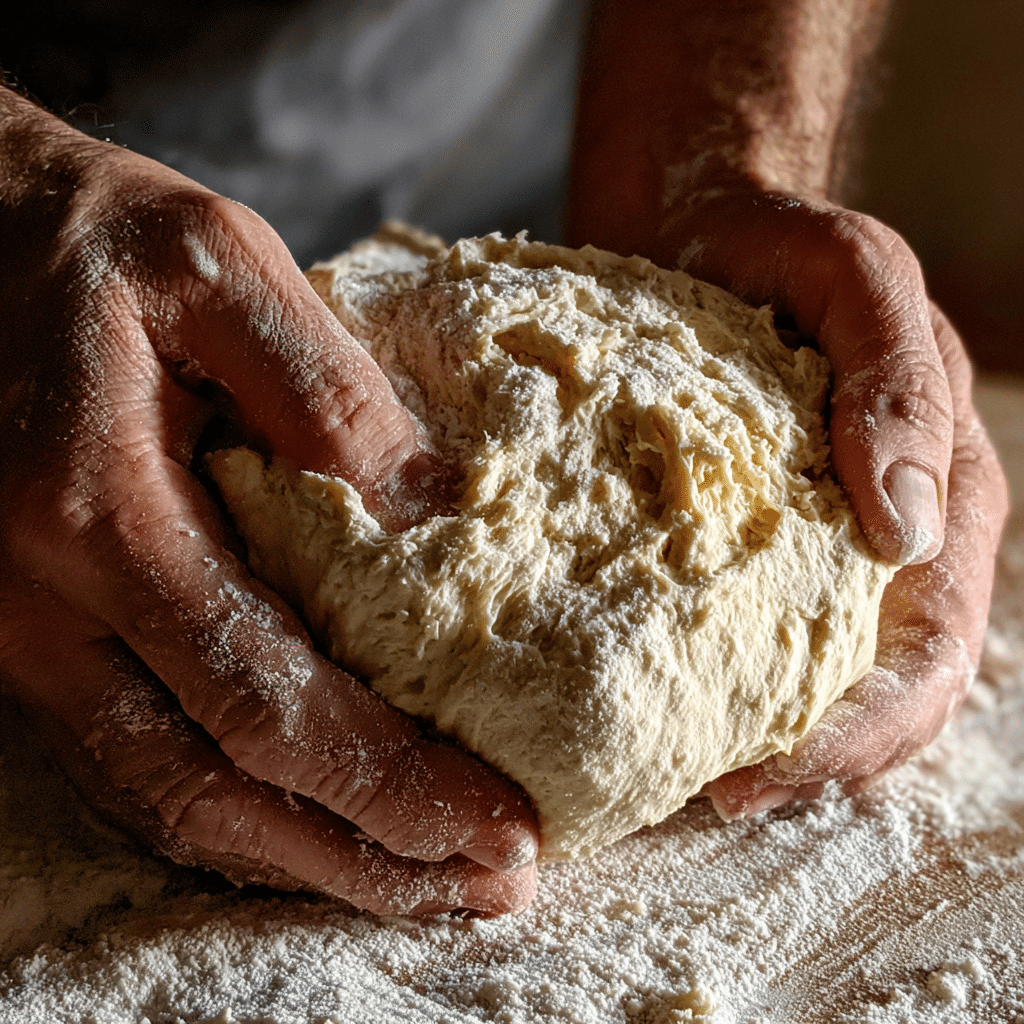
How Fermentation Affects Gluten Content
One of the biggest misconceptions about sourdough is that fermentation “kills off” gluten. That’s not entirely true. Traditional sourdough fermentation does break down some gluten proteins, especially the harder-to-digest ones, but it doesn’t eliminate gluten entirely. That means anyone with celiac disease or a gluten allergy still needs to steer clear of wheat-based sourdough.
But when you start with gluten free sourdough bread, fermentation still offers major benefits. It helps develop flavor, improves digestibility, and supports better gut health by reducing anti-nutrients like phytic acid. You get all the tang, chew, and nutritional perks—without the gluten risk.
Plus, gluten-free fermentation is usually a bit faster. The flours don’t behave exactly like wheat, but they’re wonderfully forgiving if you follow a few simple steps.
So yes gluten free sourdough bread isn’t just real, it’s better than you might expect.
The Best Gluten-Free Flours for Sourdough
Top Gluten-Free Flours for Sourdough Bread Making
When it comes to baking gluten free sourdough bread, choosing the right flour is where the magic starts or flops. Unlike wheat flour, which contains gluten to hold everything together, gluten-free flours need a little help and a good balance of protein, starch, and flavor.
Here are some of the best gluten-free flours you can use in sourdough baking:
| Flour Type | Flavor Profile | Best For |
|---|---|---|
| Brown Rice Flour | Mild, nutty | Starter and bread base |
| Sorghum Flour | Earthy, sweet | Structure and protein |
| Teff Flour | Slightly tangy, rich | Depth of flavor, nutrition boost |
| Millet Flour | Light, slightly sweet | Soft texture, mild flavor |
| Buckwheat Flour | Bold, nutty | Rustic loaves, color contrast |
| Tapioca Starch | Neutral, slightly sweet | Binding, chewiness |
| Potato Starch | Smooth, light | Moisture retention, softness |
Each flour brings something unique to the table. Brown rice flour is a go-to for building a gluten-free starter it ferments well and has a neutral taste. Sorghum adds body, while teff and buckwheat deepen flavor.
Want to experiment? Check out Gluten-Free Mexican Food for ideas on how different gluten-free flours shine in savory recipes too.
How to Create the Perfect Blend at Home
The best gluten free sourdough bread recipes often use a custom blend of flours rather than just one. This mimics the texture and structure of wheat while keeping everything 100% gluten-free. Here’s a simple formula that works beautifully for beginners:
Basic Gluten-Free Sourdough Flour Blend:
- 40% Brown rice flour
- 30% Sorghum or millet flour
- 15% Tapioca starch
- 15% Potato starch
You can tweak the ratios based on what you have. Just remember: too much starch and your bread might be gummy. Too little, and it might crumble. Balance is key.
Pro Tip: Always weigh your flours in grams for consistency. One cup of sorghum flour doesn’t weigh the same as a cup of potato starch!
Using a variety of whole grain gluten-free flours not only improves the texture it also makes your bread more nutritious and flavorful. That’s a win-win for your tastebuds and your gut.
Building and Feeding a Gluten-Free Starter
Step-by-Step: How to Make a Gluten-Free Sourdough Starter
If you’ve never made a sourdough starter before, don’t worry it’s simpler than it sounds. A starter is just flour, water, and time. And when you’re baking gluten free sourdough bread, the key difference is the flour.
Here’s how to build your own bubbly, healthy gluten-free sourdough starter in 5 easy days:
| Day | What to Do |
|---|---|
| Day 1 | Mix 1/2 cup brown rice flour + 1/4 cup filtered water in a clean jar. Stir, cover loosely. |
| Day 2 | Stir again. Add 1/4 cup flour + 2 tbsp water. |
| Day 3 | Discard half. Add 1/4 cup flour + 2 tbsp water. Bubbles may appear. |
| Day 4 | Repeat feeding. By now it should smell slightly sour. |
| Day 5 | If it’s doubling in size within 4–6 hours, it’s ready to bake. |
Make sure you use non-chlorinated water and avoid metal spoons or lids they can mess with the fermentation. If you’re in a cooler climate, keep the jar in a warm, draft-free spot like the top of your fridge.
Noticing nothing after 3 days? No worries. Gluten-free starters sometimes take a little longer. Keep feeding it regularly, and trust the process.
Want a little change of pace while it ferments?
Check out Cottage Cheese Banana Bread for an easy, non-sourdough bake with lots of protein.
Tips for Keeping Your Starter Happy and Active
Here’s how to keep your gluten-free starter thriving long-term:
- Feed it daily if it stays on the counter.
- If refrigerated, feed once a week and let it sit out for a few hours afterward.
- Always discard some before feeding to avoid overflow and sluggish growth.
- Stick with one flour (brown rice or sorghum work best) until the starter is strong.
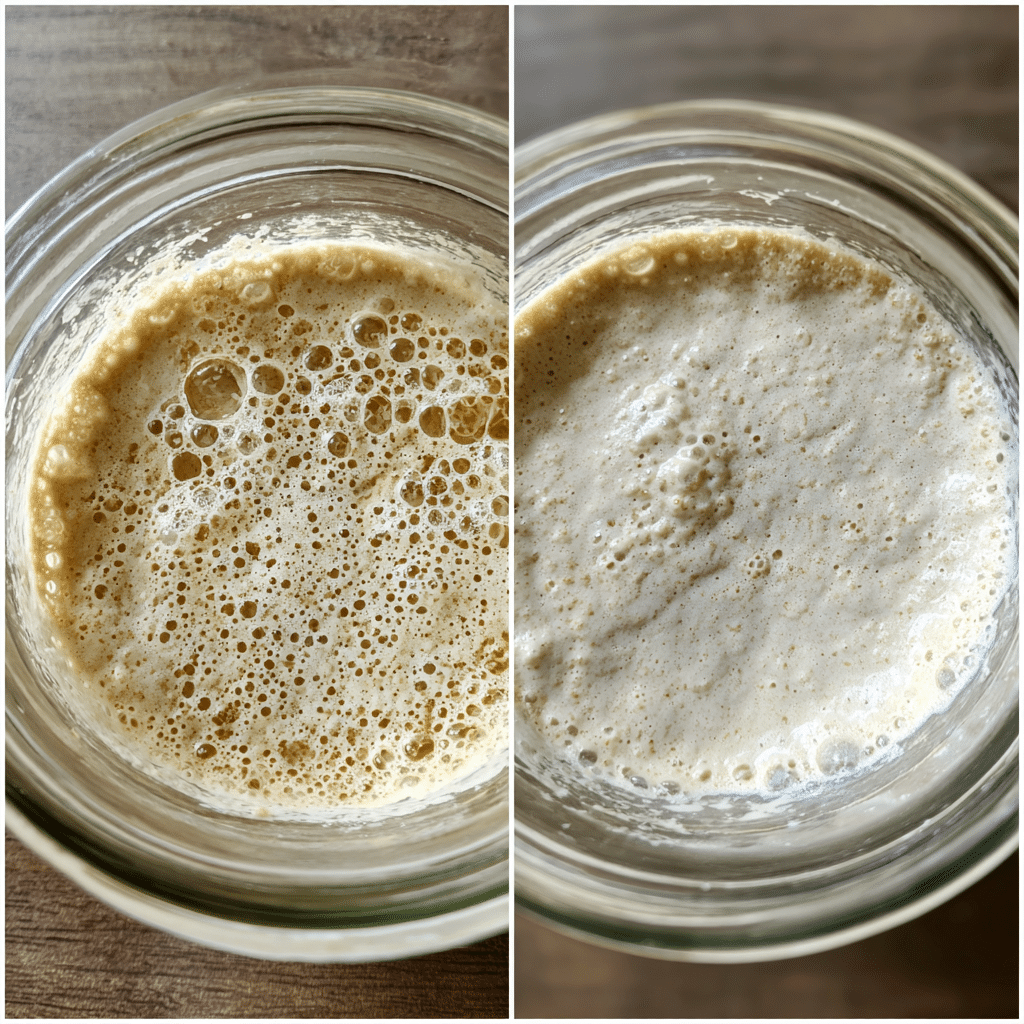
Bonus tip: Label your jar with the date you started. Watching it come alive over the week is part of the fun.
A healthy gluten-free starter should smell pleasantly sour, have visible bubbles, and double in volume a few hours after feeding. Once you’ve got that, you’re ready to make incredible gluten free sourdough bread anytime.
Baking the Bread – Techniques & Tools
Essential Equipment for Gluten-Free Sourdough Success
When you’re baking gluten free sourdough bread, you don’t need a high-tech kitchen just the right tools to set yourself up for success. Here’s what I use in my own kitchen in Asheville:
- Digital Kitchen Scale – Accuracy is everything, especially with gluten-free flours.
- Glass Jar or Crock – For your sourdough starter.
- Mixing Bowl – Medium to large size, preferably glass or ceramic.
- Dough Whisk or Sturdy Spoon – Gluten-free dough is sticky; you’ll need something strong.
- Bench Scraper – Helpful for shaping the dough.
- Dutch Oven or Covered Baking Dish – Creates that crispy crust by trapping steam.
- Parchment Paper – Makes transferring sticky dough easy.
- Proofing Basket or Bowl with Towel – Optional, but useful for shaping and resting.
If you’re serious about getting consistent rise and texture in your gluten free sourdough bread, I strongly recommend using a Dutch oven. It holds in steam, helping the loaf rise tall and crusty. But don’t let equipment stop you your bread will still be delicious with just a baking tray and confidence.
Need an easy add-on for your baking day?
Looking for inspiration? Try Walnut Butter as a perfect spread for your fresh sourdough slice.
From Mixing to Proofing: A Foolproof Gluten-Free Recipe
Here’s my go-to recipe for gluten free sourdough bread crafted to give you real flavor and structure without gums or preservatives.
Ingredients:
- 1 1/4 cups brown rice flour
- 1 cup sorghum flour
- 3/4 cup tapioca starch
- 2 tsp psyllium husk powder
- 1 1/4 cups water (filtered, room temperature)
- 1/2 cup active gluten-free sourdough starter
- 1 tsp salt
- 1 tsp olive oil (optional)
Instructions:
- Mix Dry Ingredients
In a large bowl, combine all the flours and salt these are the foundation of a great gluten free sourdough bread loaf. - Add Wet Ingredients
Pour in the water, starter, and oil. Stir well until it forms a sticky dough. Let it rest for 30 minutes. - Shape & Rest
Shape the dough and transfer it to a lined bowl or proofing basket. Let it rise 4–6 hours. The tangy aroma tells you it’s ready. - Preheat & Bake
Preheat your oven to 450°F with your Dutch oven inside. Bake the dough covered for 30 minutes, then uncovered for 20 until the crust is golden and sounds hollow. - Cool Completely
Let your gluten free sourdough bread cool completely before slicing. This keeps the crumb firm and springy.
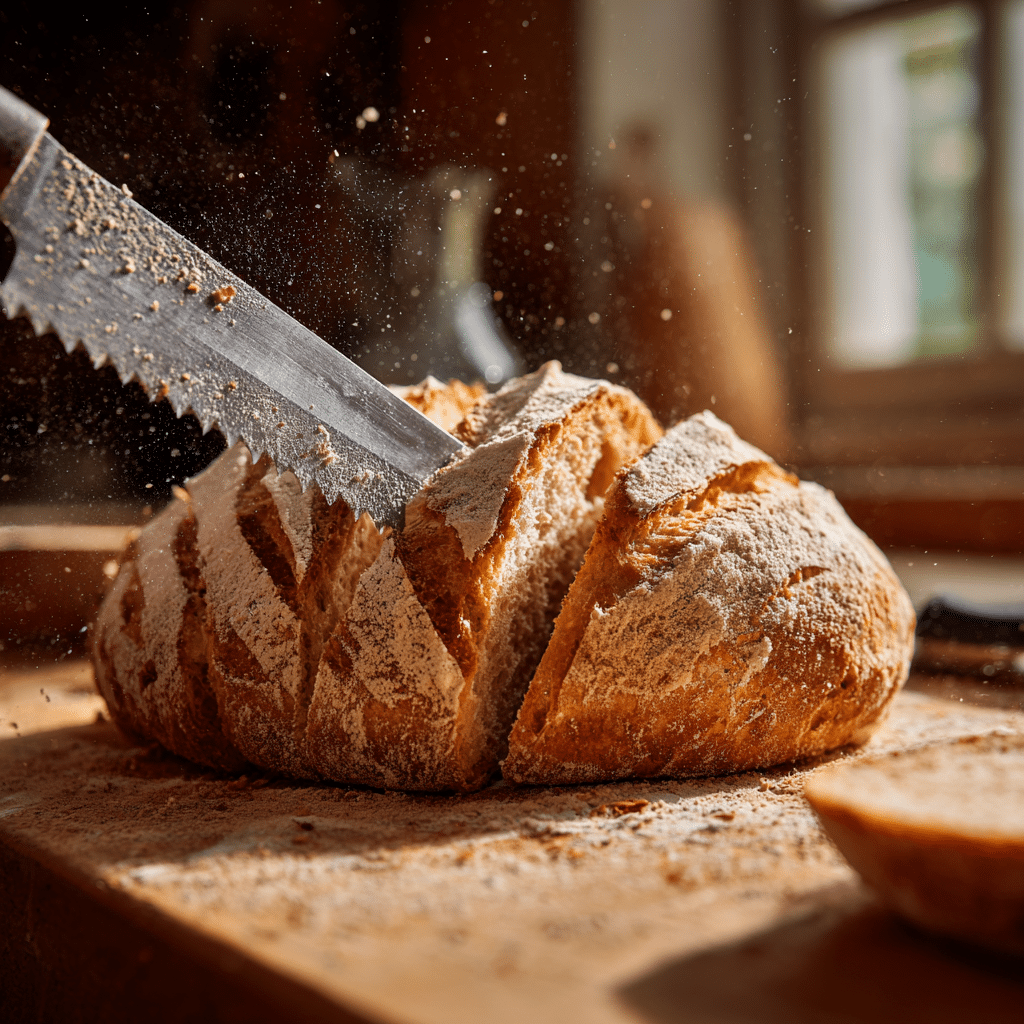
Whether it’s your first loaf or your tenth, this recipe will bring you closer to that perfect slice of homemade gluten free sourdough bread the kind that fills the kitchen with warmth and satisfaction.
Benefits & Where to Buy
Is Gluten Free Sourdough Bread Anti-Inflammatory?
If you’re looking for a bread that loves your gut back, gluten free sourdough bread might just be your new pantry staple. Thanks to the fermentation process, sourdough naturally breaks down compounds like phytic acid, making nutrients more bioavailable and easier to digest.
Even better? When made with whole grain, gluten-free flours like buckwheat, sorghum, or teff, this bread can support anti-inflammatory diets. These flours are rich in antioxidants, fiber, and minerals, and when paired with slow fermentation, they’re gentler on the gut and may reduce symptoms of bloating, fatigue, or skin irritation—often linked to inflammation.
Of course, every body is different. But many gluten-sensitive folks (myself included!) find that a well-fermented, homemade gluten free sourdough bread is a game-changer when it comes to comfort and wellness.
Can You Buy Sourdough That’s Gluten Free in Stores or Online?
Short answer? Yes. Long answer? Read the labels carefully.
There are some great bakeries and brands out there producing certified gluten free sourdough bread—meaning it’s made in facilities that avoid cross-contamination. You’ll often find these loaves in the freezer section of health food stores or online at specialty shops.
Here are some tips when shopping for gluten-free sourdough:
- Look for certification like GFCO or CSA.
- Check ingredients—avoid gums and long lists of additives.
- Call the bakery if you’re unsure; smaller companies are often transparent.
- Avoid “wheat-based sourdough” labeled as low-gluten. It’s not the same.
Some of my favorite U.S.-based brands include Simple Kneads, Bread Srsly, and Young Kobras—they’re flavorful, truly gluten-free, and ship nationwide.
But remember, there’s something extra special about baking your own. When you shape and bake your own loaf of gluten free sourdough bread, you control every ingredient—and that’s real peace of mind.
The Joy of Baking Gluten Free Sourdough Bread
There’s something powerful about pulling a homemade loaf from your oven especially one that’s been slowly fermented, lovingly shaped, and baked to golden perfection. And when that loaf is a gluten free sourdough bread, it’s not just a recipe it’s a win for your gut, your taste buds, and your creativity.
Whether you’re here because of dietary needs or simply the challenge of mastering this beautiful bread, know this: gluten-free doesn’t mean flavor-free. In fact, you may just discover that your best loaf yet doesn’t contain wheat at all.
So grab your starter, pick your flours, and get ready to turn your kitchen into a fermentation-friendly zone. With each bake, you’re not just making bread you’re making something nourishing, grounding, and totally worth sharing.
Check out Sourdough Discard Biscuits if you’ve got leftover starter and want to keep that zero-waste baking energy going
Frequently Asked Questions
Is gluten free sourdough bread possible?
Yes! With the right flours and a dedicated gluten-free starter, it’s not only possible—it’s flavorful, crusty, and nourishing.
What type of gluten-free flour is best for sourdough?
A blend works best: brown rice flour, sorghum, and teff provide structure and taste, while tapioca or potato starch adds stretch.
Is sourdough bread anti-inflammatory?
Sourdough can support digestion by lowering phytic acid and boosting nutrient absorption. Gluten-free flours like buckwheat or millet enhance its anti-inflammatory potential.
Can you buy sourdough gluten free?
Yes, just make sure it’s certified gluten-free to avoid hidden traces of gluten. Many artisan bakeries now offer delicious options.
👉 Want to see more recipe tips, flavor pairings, and behind-the-scenes updates?
Follow us on Facebook: Recipe by Clara

